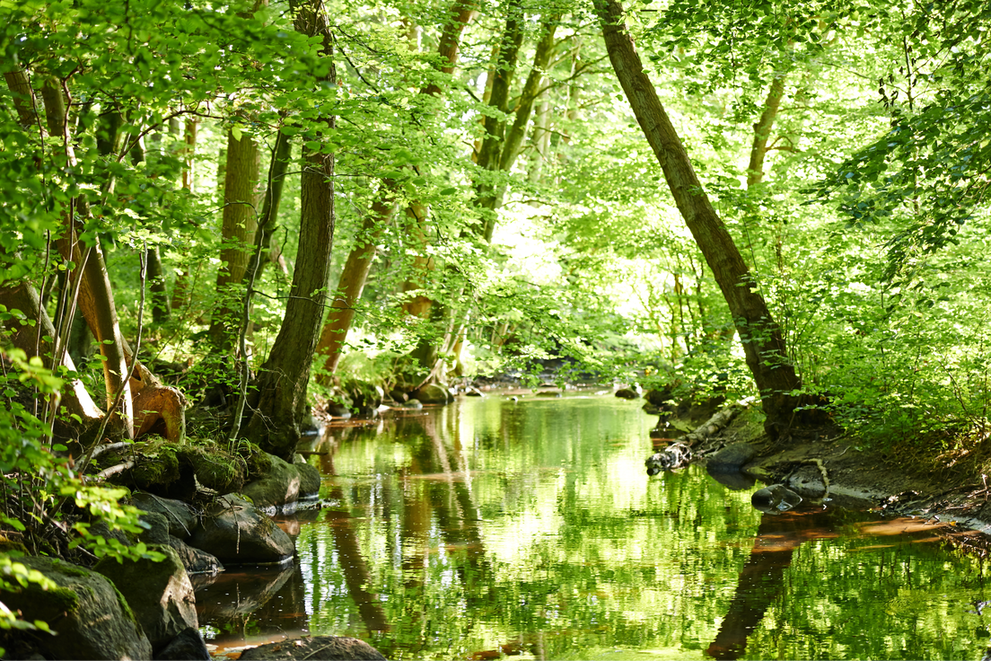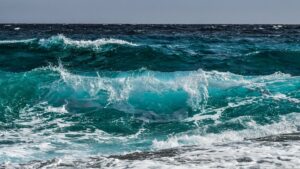How Plastics Affect Ocean Health?
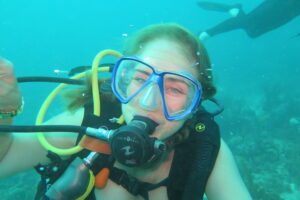
To better understand the impact of plastics on Ocean health, I interviewed Antoinette Vermilye, co-founder of ‘Gallifrey Foundation‘ and member of the global movement ‘Break Free From Plastic‘ comprising over 1,500 global members.
Gallifrey supported several marine plastics studies and specifically the work of the IUCN, ‘International Union for the Conservation of Nature’ on marine plastics and deep seabed mining.
How did your passion for the Ocean begin?
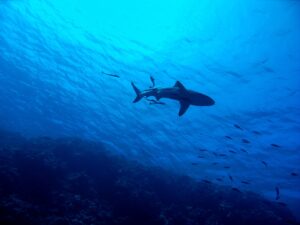 As I grew up in West Africa, I lived by the Ocean and learned that the best interaction I can have with Nature is when I immerse myself in it. Underwater I can watch interactions between marine creatures and myself – fishes come to see me.
As I grew up in West Africa, I lived by the Ocean and learned that the best interaction I can have with Nature is when I immerse myself in it. Underwater I can watch interactions between marine creatures and myself – fishes come to see me.
I also swim with sharks because I want to better understand them by observing their behavior. Sharks are guardians of the Ocean. To summarize, being in the Ocean is like seeing stories unfolding in a silent and blue-colored world.
What does the Ocean mean for you?
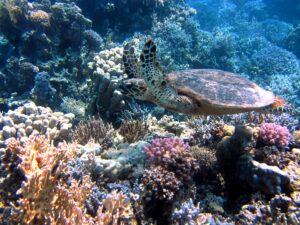 I would say love and life. The Ocean is our mother and source: she is the water we drink, the air we breathe, and the fear, joy, and wonder we feel. We tend to look at the surface of the Ocean, but there is so much going on underneath; it is a profound vertical way down. The Ocean has an incredible ecosystem and so much to discover every time.
I would say love and life. The Ocean is our mother and source: she is the water we drink, the air we breathe, and the fear, joy, and wonder we feel. We tend to look at the surface of the Ocean, but there is so much going on underneath; it is a profound vertical way down. The Ocean has an incredible ecosystem and so much to discover every time.
What are the most critical environmental problems threatening the Ocean? And how do plastic issues weigh compared to the other pressing environmental problems?
There are mainly five big environmental problems threatening the Ocean, all happening at the same time and impacting each other.
How these five environmental issues weigh one against the other is not really the question. What is important is to bear in mind that these five issues are all threats, and they influence each other, so it makes the situation worse off.
1. Overheating
As temperatures rise, the Ocean absorbs a more significant proportion of excess heat from the atmosphere, resulting in Ocean warming and impacting marine habitats and populations.
However, not all marine species have the same adaptation capacity to temperatures rise. If you are a fish, you can hopefully swim somewhere else, but if you are a coral, you are not so fortunate.
2. Deoxygenation
Greenhouse gas emissions exacerbate Ocean warming, which, combined with discharges into the Ocean of waste from agriculture, sewage, and other human activities, increases nitrogen and phosphorus inputs in the Ocean.
Among possible impacts, warmth plus nutrients together increase algal blooms that lead to microbial consumption of oxygen (1). Algal blooms can cause colossal die-offs and dead zones on a vertical and horizontal plane along coastal areas; some have the size of Mexico.(2)
3. Acidification
As the Ocean continues to absorb excess CO2 from the atmosphere due mainly to fossil fuel burning, industrial activities, and deforestation, the sea becomes more acidic, which can affect marine creatures that depend on less acidic waters to thrive. Should this collapse, it will impact the entire food chain and even Ocean oxygen(3).
For example, plankton and coral both produce oxygen. However, the acidification of waters reduces the population of plankton and coral because both have a calcareous structure. As their population decreases, it reduces the production of oxygen.
4. Over extraction
Overfishing is one of the most significant drives of decline in marine wildlife populations. We currently extract the equivalent of the weight of the Chinese population in fish annually(4).
Today, a third of all fish have been pushed beyond their biological limits. This is due to unsustainable fishing practices and bycatch, both of which cause the needless loss of billions of creatures annually.
Coastal and indigenous peoples in developing countries rely on fish for protein, but this is being extracted by commercial vessels depriving them of their natural resources.(5)
5. Plastic and chemical pollution
- Macroplastics (or mismanaged waste) are visible garbage that enters the Ocean. Up to 12 Million tons leak into the Ocean per year.(6)
- Microplastics are smaller than 5mm and enter the Ocean either because of macroplastics that decompose in the Ocean or plastics that enter the ocean via the coast, waterways, or air. Microplastics account for 1.5 Million tons per year.(7)
Creatures in the Ocean eat macro or microplastics or fragments directly and indirectly via bioaccumulation when a bigger fish eats several fish with plastic and their microplastics and toxins in their stomachs and flesh.
This biomagnification process results in a high level of toxins in fishes consumed by humans who will ingest those microplastics and their toxins. Besides, when plastic fragments are lodged in the creature’s body, it can cause slow and excruciating death.(7)
- Fishing nets are also a big problem for biodiversity because they can float below the Ocean, still capturing turtles, whales, and fish, and then rest on corals suffocating them. Fishing nets account for 0.5M tons per year.(8)
- Chemical pollution is often overlooked: rainwater, flooding, and stormwater transport toxic land pollutants to the Ocean via nearby streams, rivers, and estuaries. Cities and agriculture are mainly responsible for industrial and commercial pollutants as they don’t have good sewer systems or water treatment. Many health and body care products also end up in our Ocean. These are also responsible for acidification and toxic to marine life.
There are five garbage patches in the Ocean, and one of them has twice the size of France’s surface. Are there feasible actions we can take to clean at least partly these garbage patches?

A big misconception is that these garbage patches are mainly visible on the surface. In fact, most of these areas float below the surface, gathering mainly between 2-10m below water. Also, 90% of these areas are comprised of a plastic soup of smaller fragments rather than entire pieces of plastic.(9)
Consider that sending out large ships fuelled by heavy fuel oils to the middle of the Ocean is producing more GHG pollution than literally scooping up the equivalent of a grain of salt on a football field. It just doesn’t make sense.
However, if a fishing boat were to extract discarded fishing nets (or large plastic) wherever they are, then perhaps that would be a good opportunity to clean the Ocean from plastic.
Nonetheless, even though we were capable of cleaning all the surfaces, then what were we going to do with all the plastic, and how were we going to prevent new leakages?
Rather we need to act at the starting point and prevent macro and microplastic from entering the Ocean at river mouths and coastlines. Even most effective, stopping virgin plastic overproduction and ensuring proper waste management are the actions we need to take.
If we can’t clean these five garbage patches in the Ocean, what can we do instead?
Concretely, here are three examples of what can be done:
- 10 major food manufacturers would need to take responsibility and change their production and distribution processes. As such, food in Africa and Asia shouldn’t be wrapped in plastic.
- A small village can manage to decrease its plastic consumption and recycle everything (except plastic). It is not only affordable for villages, but also it creates jobs and avoids wastes and chemicals infiltrating water. A city in the Philippines has achieved this with great success
- Business schools can take the lead in these topics and teach their students sustainable ways to do business.
What’s the future of these garbage patches?
I think we need to be humble enough and admit we don’t know what to do with it and wait till safer technology exists, BUT we must stop more plastic from entering the Ocean URGENTLY.
How would you explain to people what’s the loss if marine wildlife disappears?
 Look at the joy you feel when you come across a dolphin or a beautiful sea bird. Consider your amazement when you see a creature. It’s wonder and joy. We are all born with this connection with Nature. If we lose marine wildlife, it will impact the entire ecosystem.
Look at the joy you feel when you come across a dolphin or a beautiful sea bird. Consider your amazement when you see a creature. It’s wonder and joy. We are all born with this connection with Nature. If we lose marine wildlife, it will impact the entire ecosystem.
Take the example of the plankton that produce some of our oxygen: they are small but are vital to maintaining life on earth. One small change in the chain has tremendous exponential impacts.
The problem today is that we are losing a lot at an increasing rate, and most species don’t have time to adapt to the exacerbating stressors in their Ocean homes.
Do you have a message of hope to share?
The Ocean requires love, and love comes from respect. We need to respect our planet and remind ourselves of our connection to Nature. This connection is an honour and privilege. Only when people will understand they are part of Nature will they act to protect the planet.



